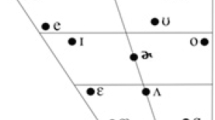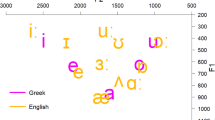Abstract
Proficiency in a second language (L2) may depend upon the age of exposure and the continued use of the mother tongue (L1) during L2 acquisition. The effect of early L2 exposure on the preattentive perception of native and non-native vowel contrasts was studied by measuring the mismatch negativity (MMN) response from 14-year-old children. The test group consisted of six Finnish children who had participated in English immersion education. The control group consisted of eight monolingual Finns. The subjects were presented with Finnish and English synthetic vowel contrasts. The aim was to see whether early exposure had resulted in the development of a new language-specific memory trace for the contrast phonemically irrelevant in L1. The results indicated that only the contrast with the largest acoustic distance elicited an MMN response in the Bilingual group, while the Monolingual group showed a response also to the native contrast. This may suggest that native-like memory traces for prototypical vowels were not formed in early language immersion.
Similar content being viewed by others
References
Aaltonen O., Suonpää J. (1983). Computerized two-dimensional model for Finnish vowel identifications. Audiology, 22, 410–415
Best C., Strange W. (1992). Effects of phonological and phonetic factors on cross-language perception of approximants. Journal of Phonetics, 20, 305–330
Cheour M., Ceponiene R., Lehtokoski A., Luuk A., Allik J., Alho K., Näätänen R. (1998). Development of language-specific phoneme representations in the infant brain. Nature Neuroscience, 1(5):351–353
Cheour M., Leppänen P., Kraus N. (2000). Mismatch negativity (MMN) as a tool for investigating auditory discrimination and sensory memory in infants and children. Clinical Neurophysiology, 111, 2–16
Cheour M., Martynova O., Näätänen R., Erkkola R., Sillanpää M., Kero P., Raz A., Kaipio M.-L., Hiltunen J., Aaltonen O., Savela J., Hämäläinen H. (2002a). Speech sounds learned by sleeping newborns. Nature, 415, 599–600
Cheour M., Shestakova A., Alku P., Ceponiene R., Näätänen R. (2002b). Mismatch negativity shows that 3–6-year-old children can learn to discriminate non-native sounds within two months. Neuroscience Letters, 325, 187–190
Dowd A., Smith J.R., Wolfe J. (1998). Learning to pronounce vowel sounds in a foreign language using acoustic measurements of the vocal tract as feedback in real time. Language and Speech, 41, 1–20
Flege J.E. (1987). The production of “new” and “similar” phones in a foreign language: evidence of speech perception. Journal of Phonetics, 15, 47–65
Flege J.E. (1991). Age of learning affects the authenticity of voice-onset time (VOT) in stop consonants produced in a second language. Journal of the Acoustical Society of America, 89, 395–411
Flege J.E., Bohn O.-S., Jang S. (1997). Effects of experience on non-native speakers’ production and perception of English vowels. Journal of Phonetics, 25, 437–370
Flege J.E., MacKay I.R.A. (2004). Perceiving vowels in a second language. Studies in Second Language Acquisition, 24, 1–34
Flege J.E., Yeni-Komshian G., Liu S. (1999). Age constraints on second-language acquisition. Journal of Memory and Language, 41, 78–104
Iverson P., Kuhl P.K., Akahaene-Yamada R., Diesch E., Tohkura Y., Kettermann A., Siebert C. (2003). A perceptual interference account of acquisition difficulties for non-native phonemes. Cognition, 87, 47–57
Kuhl P.K. (2000). A new view of language acquisition. Proceedings of the National Academy of Science USA, 97:11850–11857
Kuhl P.K., Williams K.A., Lacerda F., Lindblom B. (1992). Language experience alters phonetic perception in infants by 6 months of age. Science, 255, 606–608
Mayberry R.I., Lock E. (2003). Age constraints on first versus second language acquisition: evidence for linguistic plasticity and epigenesis. Brain and Language, 87, 369–384
Näätänen R., Gaillard A.W.K., Mäntysalo S. (1978). Early selective attention effect on evoked potential interpretation. Acta Psychologica, 42, 313–329
Näätänen R., Lehtokoski A., Lennes M., Cheour M., Huotilainen M., Iivonen A., Vainio M., Alku P., Ilmoniemi R.J., Luuk A., Allik J., Sinkkonen J., Alho K.(1997). Language-specific phoneme representations revealed by electric and magnetic brain responses. Nature, 358, 392–397
Pallier C., Bosch L., Sebastián-Gallés N. (1997). A limit to behavioural plasticity in speech perception. Cognition, 64:B9–B17
Peltola M.S. (2003). The attentive and preattentive perception of native and non-native vowels: the effect of second language learning. Turku, University of Turku
Peltola M.S., Kujala T., Tuomainen J., Ek M., Aaltonen O., Näätänen R. (2003). Native and foreign vowel discrimination as indexed by the mismatch negativity (MMN) response. Neuroscience Letters, 352, 25–28
Peltola M.S., Kuntola M., Tamminen H., Hämäläinen H., Aaltonen O. (2005). Early exposure to non-native language alters preattentive vowels discrimination. Neuroscience Letters, 388: 121–125
Piske T., Flege J.E., MacKay I.R.A. (2002). The production of English vowels by fluent early and late Italian-English bilinguals. Phonetica, 59, 49–71
Polka L., Werker J.F. (1994). Developmental changes in perception of native and nonnative vowel contrasts. Journal of Experimental Psychology: Human Perception and Performance, 20:297–314
Tainturier M.J., Johnson E., Tamminen J., Thierry G. (2003). An ERP investigation of age-of-acquisition effects in spoken word recognition. Brain and Language, 87, 15–16
Wiik K. (1965). Finnish and English vowels. Turku, University of Turku
Winkler I., Kujala T., Tiitinen H., Sivonen P., Alku P., Lehtokoski A., Czigler I., Csépe V., Näätänen R. (1999a). Brain responses reveal the learning of foreign language phonemes. Psychophysiology, 26, 638–642
Winkler I., Lehtokoski A., Alku P., Vainio M., Czigler I., Csépe V., Aaltonen O., Raimo I., Alho K., Lang H., Iivonen A. Näätänen R. (1999b). Pre-attentive detection of vowel contrasts utilizes both phonetic and auditory memory representations. Cognitive Brain Research, 7, 357–369
Author information
Authors and Affiliations
Corresponding author
Rights and permissions
About this article
Cite this article
Peltola, M.S., Tuomainen, O., Koskinen, M. et al. The Effect of Language Immersion Education on the Preattentive Perception of Native and Non-native Vowel Contrasts. J Psycholinguist Res 36, 15–23 (2007). https://doi.org/10.1007/s10936-006-9030-y
Published:
Issue Date:
DOI: https://doi.org/10.1007/s10936-006-9030-y




